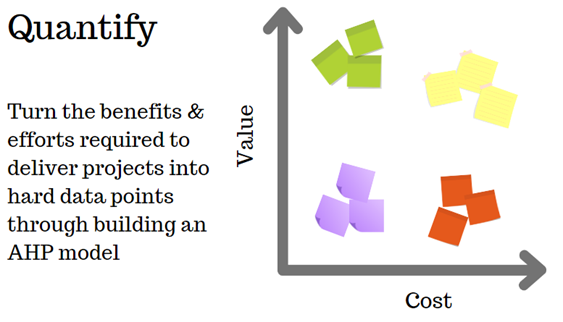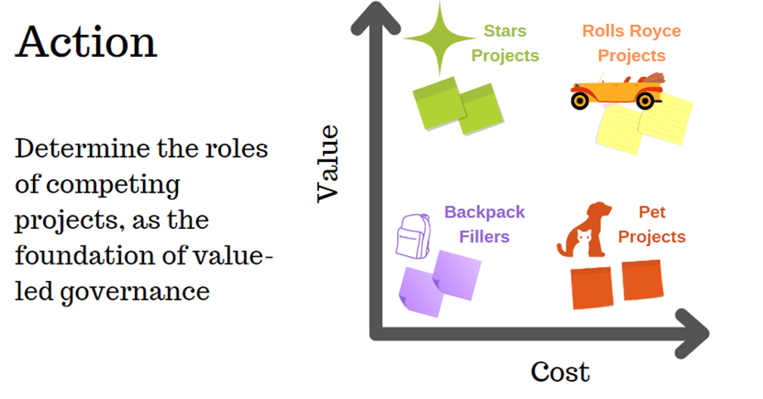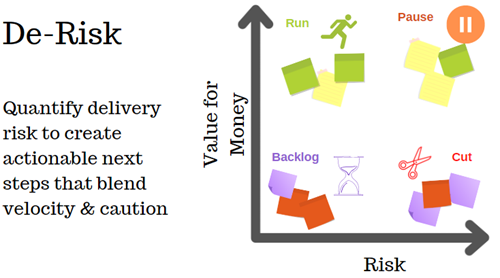Prioritization - The Efficient Frontier
Updated:
Published:
Captain’s Log: Our portfolio is floating in space, lacking direction and under attack from a grumpy CEO who is annoyed at not being able to deliver strategy, while the crew keep getting vaporized by a schedule stuffed with Too Many Projects.
What can we do? We need a special phaser that can zap the Klingons who are all shouting at us and demanding their projects get done first… let’s ask Spock… he’s smart.

Well Jim, we need to be able to measure these projects. With just 4 simple data visualizations (including the Efficient Frontier) we can take control of our portfolio. If we can create a quantifiable value for all our projects and compare this to their cost, then we might just be able to live long enough to prosper.
It's either that or a quick Vulcan Death Grip for the next person to demand their project is added to the backlog.
1. Quantify what Value & Cost mean to your organization
No two organizations share the same goals, so no scoring model is universally transferable. Or put another way - to define value, you must be able to articulate what matters to you. This could mean balancing short and long-term goals, making trade-offs between savings and growth, or determining the relative importance of different stakeholders. Indeed, it might be all of the above at the same time.
The best way to do this is with an AHP model. AHP stands for Analytic Hierarchy Process. Learn more about it here. Compared to purely financial analysis it builds in impossible-to-quantify criteria. Compared to Product models such as Kano, RICE and MoSCoW it offers far greater adaptability to the specific requirements of a portfolio.
Similarly defining ‘cost’ in the context of planning is critical. For most this means blending capital spend with people costs, then applying estimates of effort to each project. T-Shirt sizing is a popular approach as a simple proxy to get data quickly without having to build bottom-up models.
Now combine these metrics into a scatter chart and you’ll see prioritization taking shape.
For more details check out our Ultimate Guide to Prioritization.

Captain’s Log: Our portfolio is adrift in space, under siege from a grumpy CEO and overwhelmed by too many projects.
It’s time to take control, book a demo. Learn how to measure and prioritize your projects with precision, ensuring your crew can live long and prosper.
2. Rank your projects according to Value for Money
Defining Value and Cost, means Value for Money can be used as a ‘North Star’ metric for project selection. At its simplest this means you can approve projects up to the limit of your constraints then stop. The theory (which we see time and again with real data) is that most of the value can be realized without funding all projects, thus enabling you to save money while delivering what matters.
For more complex organizations this approach can also facilitate agility in moving money between competing sub-portfolios. Simply find the point of inflection where incremental spend stops adding much value for each portfolio, and then iterate to match the limit of funds available.
To create this chart (which we call the ‘Efficient Frontier’) use the same axis as previously but make them cumulative and ranked by value for money. Thus, the PMO can facilitate a clear discussion on project choice without having to apply subjective judgements to create an achievable plan.

3. Set data-led Actions to drive better outcomes
By knowing the Value & Cost of projects we can see their role in an organization. The Star Projects are high value, low cost. They should be front of the queue, prioritized to bring forward value & give the PMO positive momentum. Conversely Pet Projects are low value, high cost, and should simply be stopped to eliminate waste, and thus improve overall value delivery.
High-value, high-cost projects should be selected according to constraints. If you can afford them, they’re great, which is why we call them the Rolls Royce Projects. However, if funds are finite (and they usually are) they need to be rationed. Finally, you have the low cost-low value projects. These ‘Backpack Fillers’ aren’t going to define success for the portfolio, but if they can drop into the roadmap around bigger commitments then do them.
These labels are of course purely illustrative. Determining the right language for your organization is important and can give the PMO a clear role in ‘owning’ the bridge between strategy and action.

4. De-Risk your portfolio by quantifying delivery risk
Once you have a quantification for value you can overlay anything as an additional lens on selection. A popular choice is determining how risky a project is. Like value, defining risk is specific to your organization. It could be complexity, disruption, third party exposure, market velocity, organizational readiness, or any number of other potential banana skins standing between a proposed project and a successful outcome. Like Value these factors are best addressed via an AHP model.
Once you have a quantifiable risk score joined to value score, you can, as we did in step 3, build simple actionable outcomes again, focused on accelerating obvious winners and pausing riskier proposals - ideally with a challenge to reduce their risk score with better plans. The key here is that accepting risk becomes a conscious choice, with tolerance determined by value. Executives hate surprises (unless there is cake), so effective PMOs need to learn to avoid them.

Next Steps
With a draft portfolio in place, you can now fine tune selections. Consider how well your plans support competing criteria in your value definition: have you got sufficient coverage for all your goals? Balance may also be important if your portfolio needs to support different departments, although be careful not to destroy too much value in the interests of being ‘fair’.
Communication is also critical. Give your executives compelling data visualizations to make it simple for them to make decisions. Give managers proposing lower-value projects clear feedback on why they are not getting funding. Give the teams doing the work visibility of the ranking so they know when to focus on saving effort and when to focus on delivering quality. Wrap this all up in language folks find relatable.
With prioritization set you can also build a roadmap, which spreads projects out within your planning horizon. Starting too many projects simultaneously reduces effectiveness and undermines confidence of impatient stakeholders. Conversely, making each quarter an achievable set of goals increases accountability, and demonstrates that the PMO is in control.
So don't be that PMO who wants to Klingon to Excel. TransparentChoice provides user-centric software for prioritizing with AHP - we reckon it's the real McCoy. We can’t promise doors that go swish, phasers you can set to stun, or the ability to beam you up (not even with our Enterprise package…) but we can help you find your Efficient Frontier, and with it the data that will help you achieve your mission.
